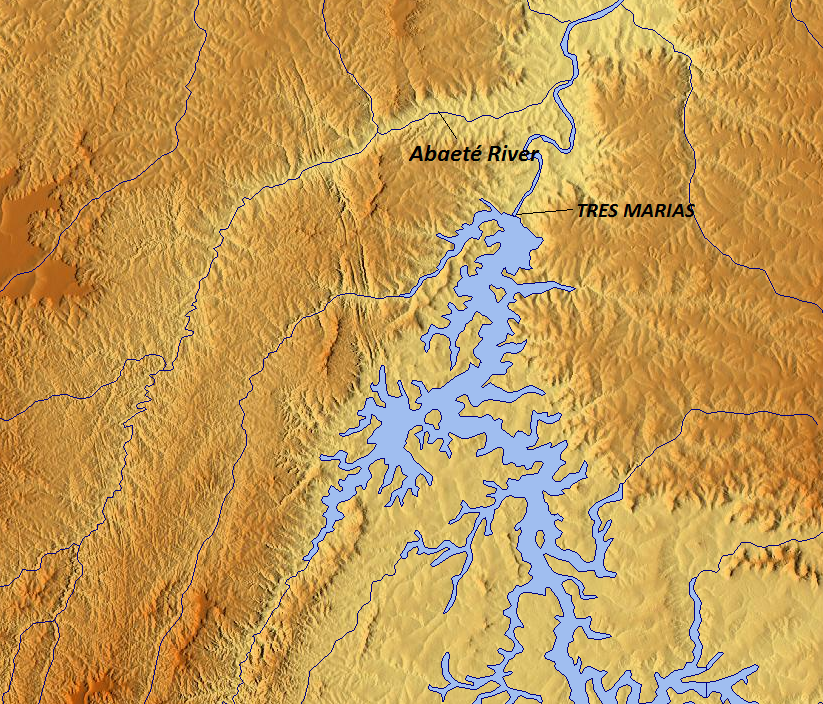Três Marias Dam on:
[Wikipedia]
[Google]
[Amazon]
The Três Marias Dam, also known as Bernardo Mascarenhas, is an embankment dam on the São Francisco River near
 The dam is a long and high embankment dam with a
The dam is a long and high embankment dam with a
Três Marias
Três Marias is a Brazilian municipality΄ in northwestern Minas Gerais. In 2020 the population was 32,716 in a total area of 2,763 km2.
Climate
The climate is tropical semi-humid, with an annual average temperature of , and an average annu ...
in Minas Gerais
Minas Gerais () is a state in Southeastern Brazil. It ranks as the second most populous, the third by gross domestic product (GDP), and the fourth largest by area in the country. The state's capital and largest city, Belo Horizonte (literally ...
, Brazil
Brazil ( pt, Brasil; ), officially the Federative Republic of Brazil (Portuguese: ), is the largest country in both South America and Latin America. At and with over 217 million people, Brazil is the world's fifth-largest country by area ...
. It was constructed for hydroelectric power production and flood control
Flood control methods are used to reduce or prevent the detrimental effects of flood waters."Flood Control", MSN Encarta, 2008 (see below: Further reading). Flood relief methods are used to reduce the effects of flood waters or high water level ...
. The dam was completed in 1961 and its first generator was operational in 1962. The dam's power plant is named after Bernard Mascarenhas who in 1889, built South America's first major hydroelectric power plant in Brazil, the Marmelos Zero Power Plant
The Marmelos Zero Power Plant is a decommissioned hydroelectric power plant on the Paraibuna River in Juiz de Fora, Minas Gerais, Brazil. Inaugurated in 1889, plant was the first major hydroelectric power plant constructed in South America, speci ...
.
Background
Construction on the dam began in May 1957 with a goal to stabilize the river's flow, improve navigation and to produce hydroelectric power. 10,000 people worked on the project and Brazilian PresidentJuscelino Kubitschek
Juscelino Kubitschek de Oliveira (; 12 September 1902 – 22 August 1976), also known by his initials JK, was a prominent Brazilian politician who served as the 21st president of Brazil from 1956 to 1961. His term was marked by economic prosp ...
was influential in the dam's construction pace. The majority of the dam works were completed in January 1961 and its first generator was operational in 1962. The other five generators went online by 1969. The dam does not have a fish ladder
A fish ladder, also known as a fishway, fish pass, fish steps, or fish cannon is a structure on or around artificial and natural barriers (such as dams, locks and waterfalls) to facilitate diadromous fishes' natural migration as well as move ...
and effectively halted fish migration in the upper São Francisco River while also splitting it into two zones.
When the reservoir was filled it formed an island that became the Pirapitinga Ecological Station, with an area of about .
Specifications
spillway
A spillway is a structure used to provide the controlled release of water downstream from a dam or levee, typically into the riverbed of the dammed river itself. In the United Kingdom, they may be known as overflow channels. Spillways ensure th ...
off to its east-side and a power plant
A power station, also referred to as a power plant and sometimes generating station or generating plant, is an industrial facility for the electricity generation, generation of electric power. Power stations are generally connected to an el ...
at its east toe. The dam's reservoir
A reservoir (; from French ''réservoir'' ) is an enlarged lake behind a dam. Such a dam may be either artificial, built to store fresh water or it may be a natural formation.
Reservoirs can be created in a number of ways, including contro ...
has a surface area of and a capacity of .
Bernard Mascarenhas Power Plant
The dam's power station, Bernard Mascarenhas Power Plant, contains six generators powered byKaplan turbine
The Kaplan turbine is a propeller-type water turbine which has adjustable blades. It was developed in 1913 by Austrian professor Viktor Kaplan, who combined automatically adjusted propeller blades with automatically adjusted wicket gates to ach ...
s for a total installed capacity of . There is additional room for two more generators in the power station which would increase the capacity to if installed. The Kaplan turbines used in the power station were designed by Voith
The Voith Group is a German manufacturer of machines for the pulp and paper industry, technical equipment for hydropower plants and drive and braking systems. The family-owned company, which operates worldwide and has its headquarters in Heid ...
and first installed in 1958. Each one has eight runner blades and is designed to operate with a hydraulic head as low as . The dam regulates downstream water flows to other reservoirs and power plants, keeping a normal discharge of .
See also
*List of power stations in Brazil
The following page lists the power stations in Brazil.
Coal
Gas and oil fired
Gas Turbines
Internal combustion engines
Nuclear
Hydroelectric
Solar
Wind
See also
*Electricity sector in Brazil
* Energy policy o ...
References
{{DEFAULTSORT:Tres Marias Dam Dams completed in 1961 Dams in Minas Gerais Embankment dams Dams on the São Francisco River